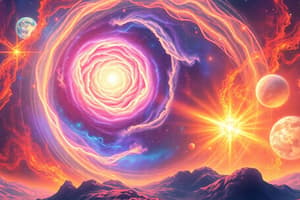Podcast
Questions and Answers
Which theory suggests that the universe has no beginning and no end in time?
Which theory suggests that the universe has no beginning and no end in time?
- Cosmic Inflation
- Steady State (correct)
- Big Bang
- Accretion
The Jovian planets are solid.
The Jovian planets are solid.
False (B)
What is the coldest layer of the Earth's atmosphere?
What is the coldest layer of the Earth's atmosphere?
Mesosphere
What process involves the gradual increase in size of celestial bodies from a nebula?
What process involves the gradual increase in size of celestial bodies from a nebula?
The _______ is the boundary of the troposphere and stratosphere.
The _______ is the boundary of the troposphere and stratosphere.
Name one characteristic of minerals.
Name one characteristic of minerals.
The outer core of the Earth is solid.
The outer core of the Earth is solid.
Match the following biomes with their descriptions:
Match the following biomes with their descriptions:
What is the main difference between intrusive and extrusive crystal formation?
What is the main difference between intrusive and extrusive crystal formation?
Which of the following is a property used in identifying minerals?
Which of the following is a property used in identifying minerals?
Study Notes
Theories about the Origin of the Universe
- Cosmic Inflation: Rapid expansion model proposed by Alan Guth.
- Steady State Theory: Continuous creation, with no distinct beginning or end in time, advocated by Fred Hoyle, maintaining constant density.
- Big Bang Theory: Suggests universe originated from an explosive force, leading to a decrease in density over time, proposed by Georges Lemaître.
Theories about the Origin of The Solar System
- Accretion: Solar system formed from a nebula that gradually increased in size.
- Protoplanet Hypothesis: Smaller masses coalesced to form larger bodies.
- Capture Theory: Jean's Theory posits the Moon's acquisition through a passing body or a direct impact.
- Modern Nebular Theory: Proposes formation in a dense disk of gas and dust.
Solar System and its Planets
- Terrestrial Planets: Characterized as solid, rocky bodies.
- Jovian Planets: Composed mainly of gases and ices.
Subsystems of the Earth
Atmosphere
- Exosphere: Outermost layer of the atmosphere.
- Thermosphere: Hottest layer, contains ions, responsible for the auroras.
- Mesosphere: Coldest layer, where meteors disintegrate.
- Stratosphere: Houses the ozone layer.
- Troposphere: Densest layer, contains weather phenomena.
- Tropopause: Boundary between troposphere and stratosphere.
- Stratopause: Boundary between stratosphere and mesosphere.
- Mesopause: Boundary between mesosphere and thermosphere.
- Thermopause: Boundary of the thermosphere.
Geosphere
- Lithosphere: Comprises the crust and the uppermost solid mantle.
- Asthenosphere: Characterized by its ductile properties.
- Mantle: Layer beneath the crust.
- Outer Core: Fluid layer surrounding the inner core.
- Inner Core: Solid center of the Earth.
- Moho: Boundary between the crust and the upper mantle.
- LAB Discontinuity: Boundary between the lithosphere and asthenosphere.
- Gutenberg Discontinuity: Boundary between mantle and outer core.
- Lehmann Discontinuity: Boundary between inner and outer core.
Hydrosphere
- Represents the total amount of water on Earth.
Biosphere
- Encompasses all life forms on Earth.
Biomes of The Earth
- Tundra: Coldest biome with permafrost.
- Taiga: Boreal forest characterized by cold climate and coniferous vegetation.
- Temperate Forest: Moderate climate, dominated by deciduous trees.
- Tropical Rainforest: Hot and humid, rich biodiversity.
- Grassland:
- Prairie: Dominated by grasses with few trees.
- Savannah: Grasses with scattered trees and a warm climate.
- Chaparral: Features drought-resistant shrubs and small trees.
- Desert: Extremely arid and dry conditions.
Minerals and Rocks
Minerals
- Homogenous Composition: Single composition throughout.
- Naturally Occurring: Forms without human intervention.
- Inorganic Solid: Not derived from living organisms.
- Definite Chemical Composition: Fixed ratio of elements or compounds.
- Ordered Internal Structure: Uniform atomic arrangement.
Crystal Formation
- Evaporation: Water evaporates, leaving solids behind.
- Cooling:
- Extrusive: Fast cooling of lava, resulting in small crystals.
- Intrusive: Slow cooling of magma, producing large crystals.
Physical and Chemical Properties
- Color: Least reliable for identification.
- Streak: Powder residue left on surfaces during the streak test.
- Luster: Light reflection quality, classified into metallic and non-metallic.
- Hardness: Resistance to scratching, measured by Mohs scale.
- Fracture vs. Cleavage: Fracture breaks unevenly; cleavage breaks along the weakest plane.
- Crystal Form: External shape of the mineral.
- Specific Gravity: Ratio of mineral density to water density.
- Acid Test: Reaction of mineral with acid.
- Magnetism: Ability to attract metals.
- Taste and Smell: Certain minerals have distinctive tastes or smells.
- Elasticity: Ability to stretch and return to original shape.
- Malleability: Ability to be shaped under force.
- Double Refraction: Phenomenon wherein light splits into two rays.
Mineral Resources
- Mineral Occurrence: Locations suspected to have valuable minerals in sufficient quantity and size.
- Mineral Deposit: Concentration or amount of minerals in an occurrence.
- Ore Deposit: Economically valuable concentration of minerals.
- Magmatic: Formed from solidified molten rocks.
- Hydrothermal: Created from heated waters below oceans.
- Sedimentary: Occurs in sedimentary rocks.
- Placer: Found at the surface with higher specific gravity.
- Residual: Formed from soil due to laterization processes.
- Leaching: Removal of mineral cover through water percolation.
- Relief: Elevation changes in the landscape.
- Laterization: Weathering process leading to the replacement of alkaline and silica content.
Studying That Suits You
Use AI to generate personalized quizzes and flashcards to suit your learning preferences.
Description
This quiz covers the theories about the origin of the universe and the solar system discussed in Earth Science Week 1. Explore concepts like Cosmic Inflation, the Steady State theory, and the Big Bang theory, along with the processes of accretion and protoplanet formation. Test your understanding of these foundational ideas in cosmology.



